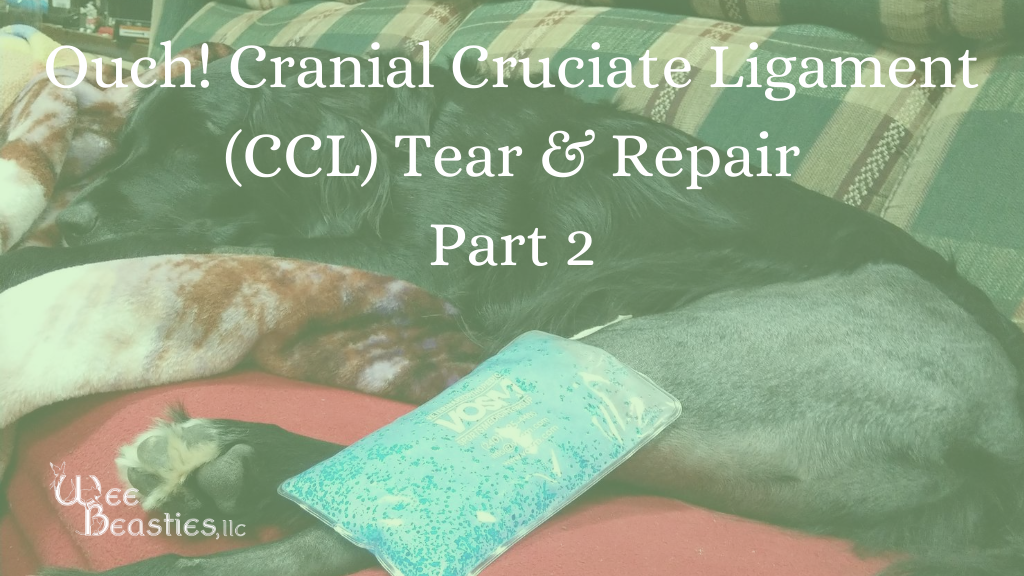Annnd, we’re back! Sorry for the delay. I’ve been struggling with some technical issues this past month.
If you missed the first part of Izzy’s story, you can find that here. Below is about the surgery and recovery.
Surgery
I rented a van for the long drive back to the specialist so that I could fold all the seats into their storage space in the floor and let Izzy lay in her bed on the floor. I bought a Kurgo Zipline and attached that to the handholds on the ceiling. It’s not rated for crashes, but I didn’t want Izzy to run away into the woods and get lost if we were in an accident. The van could also hold the dog ramp that my friend loaned to us, as well as our bags. The van had the added bonus of being low to the ground so it was easier for me to help Izzy in and out, even without the ramp. The whole set up worked quite well, and I highly recommend it if you have a big dog to transport!
Thankfully, our first surgery was scheduled well before there was even an inkling of an idea that the Coronavirus might make it to the US. I was able to go inside with Izzy and sit with her until it was time for them to take her back.
The vet tech who came to take Izzy back was very sweet and tried to make friends with Izzy before taking her away. Unfortunately, Izzy was already on high alert (vet’s office!), and the tech had on those little surgical shoe covers…so Izzy dragged her back across the room to get to me. It would have been pretty funny if I hadn’t been so nervous!
We spent the night with my friend before the surgery instead of at a hotel. She and her parents have been so kind to us through everything (and even before this honestly!). It was such a blessing to have their support, especially being so far from home.
For the second try, I walked with Izzy and the tech right up to the door where she would go. My friend followed after them and made sure Izzy was comfortable while she waited her turn.
My friend, bless her, checked on Izzy throughout the day, and even stayed late at the clinic while she waited for Izzy’s surgery to be finished. She was unfortunately the last one for the day, so it was late before we heard that she had come through just fine, and that she was resting.
Yet another thing I appreciated about the specialist was that they had techs and a doctor in the office overnight to keep an eye on all the patients recovering from their procedures. They even encouraged me to call to check on her, and the people I spoke to were very nice about everything. It really put my mind at ease knowing someone was there to check on Izzy.
The First Two Weeks
I was able to pick a loopy Izzy up the next morning, and we set out for home immediately. The vet gave us pain meds and antibiotics, and Izzy also had a shot of a long-lasting pain medication before leaving.
We stopped twice to potty, but she only went once. It was difficult for me to hold the towel just right as a sling for her so that she could squat to pee, and I definitely wished I’d practiced that before we needed it. Walking with it was much easier, though I needed a longer towel—trying to walk her with the regular one made my back ache.
You will see varying answers on when a dog will start using their leg again. Izzy was putting her toes down by the evening I picked her up after we got home, and putting her whole foot down, though without weight on it, by the next day.
We walked with the sling (the majority of the time) for about two weeks. Even though I tried to be very vigilant about jumping and such…well, Izzy had other plans. This is another area I wish we had practiced in as she became frantic when shut in the guest room with its safe furniture (ie, our mattress on the floor) and in her crate. She wound up spending most of her days in the living area with one of us, especially on the days I took off from work.
She very quickly decided that she didn’t like sleeping on the floor all the time, and knocked down my exercise pen barrier to jump up on the couch. (Cue inward cringing.) I covered the couch with various items, put the barrier back up…and came home from work to have my mom inform me that Izzy had not only knocked the barrier down, but also jumped over the items already on the couch in order to be on it. (Facepalm.) After that, I stopped trying to keep her off the couch because it was clearly going to be safer for her if I just let her get up there (where she slept the rest of the day), instead of injuring herself trying.
Recovery
While I wasn’t very good at keeping Iz off the couch, we did do an excellent job of icing/heat packing and passive range of motion exercising. Her “ankle,” called a hock in dogs, puffed up into a swollen mess the day after I brought her home so we used our double-duty bag to put warm, moist heat on it, and then I massaged it afterwards thanks to a dog massage class I took online.
Passive range of motion exercises involve having the dog lay still and relax while you gently guide the affected limb through its normal ranges of motion (or as close as you can get given any stiffness/swelling). For us, it included lifting Izzy’s operated-on-leg, and then carefully moving it in a kind of bicycling motion. Izzy did not like this process, but she tolerated it, and I stopped or skipped the session if she seemed to be in pain.
Double (Not Good) Surprise
Just before we were due to have her staples out, Izzy and I slipped in the snow/ice from a sudden (though perfectly normal) February storm. I, of course, freaked out and called my vet and then the specialist immediately, and we wound up having an extra set of x-rays in addition to our 4- and 8-week check up.
While the x-rays showed no injury to the bone or surgical implants, Izzy did manage to break her fibula (the smaller lower leg bone) between the 2-week and 4-week x-rays. I felt so horrible! Other than allowing her on the couch (which she did very carefully while holding her operated-on-leg in the air all by herself), we had all been so careful to keep her from doing anything that would hurt her.
Dr. Tsoi, the very nice intern that did our follow-up at the specialist seemed to be a bit surprised at how upset I was that I’d let that happen (though if she knew me, she wouldn’t have been!), and tried to make me feel better—apparently, it’s very common for active dogs to break their fibula during recovery—and it was already mostly healed anyway! Bless her for that…She’s a great vet with a very comforting personality. Whoever snags her up after her internship is complete is going to be very lucky to have her on their team!
Rehab
At that point, we were cleared to start doing rehab-style exercises, and I was quite pleased to find Izzy was a very willing participant! We did skip days from time to time if she seemed too painful or sore, but otherwise, we did every session. Izzy was very patient with me while I muddled through how best to complete her exercises, and I was incredibly grateful for all the dog exercise classes we had taken up to that point!
One workshop in particular, Dr. Leslie Eide’s “Progression Stagnation: Knowing When & How to Change Fitness Intensity” was extremely helpful because one of Izzy’s exercises was the “sit to stand” which is just what it sounds like—you have the dog sit, and then stand back up.
Up until that point, I rarely asked Izzy to sit because it caused her so much pain sitting and getting back up. We did not do the sit to stand right away, but focused on the other exercises for the first few weeks instead. Much later in the rehab process, I used what I had learned in Dr. Leslie’s class to make the sit part much easier for Izzy (by adding a ramp for her to stand on that reduced how far she had to go to sit down). She improved by leaps and bounds after that!
Round 2
Unfortunately, sometime after week 12, I started to notice Izzy slowing back down at things she had been enjoying, first on our walks, and then she was slow to come over for our exercise sessions, and some days she refused them at all. I could also clearly see a “wobble” in her non-operated-on leg. It was already time for surgery #2…
I had already known she would need it. I had seen the wobble in both knees before the first operation, and Dr. Leasure and Dr. Tsoi had diagnosed a partial tear in the right knee at our 4-week check up (though they suspected it before then).
But I really hadn’t expected it to happen as fast as it did. We were on lockdown for Covid-19 at this point around mid-May.
My work was starting to talk about coming back, and one Sunday, I looked at my mom and told her I wish I’d realized Izzy would need this surgery sooner. It would make the whole process so much easier if I could be with her around the clock like I was while working from home, not to mention, I hadn’t rebuilt enough vacation time to take every other day off like I had before.
Clearly, my prayers were heard though!
The very next day, my boss relayed to us from a meeting that we would likely not go back until mid to late June. I cheered and immediately called first my vet to get pre-surgical bloodwork and x-rays, and then the specialist to see when we could get in….and they were able to take us the very next week…three months minus one day since the first surgery!

It was all quite a whirlwind this time. I didn’t have months leading up to it to get anxious. And I didn’t have time to save up for the procedure either, so I applied for something called “CareCredit” for the second surgery. It’s a credit card specifically for human medical and veterinary costs, and it often comes with special financing deals when you pay for something that meets a certain threshold at participating practices. (PS: I’m not being paid to tell you about CareCredit. Just wanted to share my experience.)
In our case, I received one year of interest-free financing to pay for Izzy’s surgery. If I don’t pay it off before then, I’ll owe all the interest that would have accrued over that year, but the payment is reasonable, and I don’t see that happening. I’m actually quite pleased to have it now to use in conjunction with the savings account I have for my pets. It will be handy to have in an emergency.
The second surgery went well, and we started our recovery all over again, though this time I was home for all of it…because, as you know, the Corona lockdown lasted much longer than anyone anticipated!
A Few Differences
Izzy had stitches for her second surgery, and I will say that the staples from the first time seemed to do much better. She did not like the stitches, and I had to keep a close eye on her to make sure she wasn’t licking or chewing on them (we went with dog pajamas over the cone of shame, and they were very helpful though warmer than I’d have liked for summer time). In addition, the stapled suture definitely seemed to heal up faster.
In addition to the stitch/staple switch, Izzy had significantly more swelling in her hock the second time around. Her little ankle was so swollen that she couldn’t bend her lower leg at all for almost a week, even with the heat packs and massages. I had to help her more with the towel this time to keep her from dragging that leg on the ground since she couldn’t bend it to lift it higher.
The doc told us this was normal, and that the same surgery could create different reactions from one dog to another and even from one side of the same dog to the other, as in our case. The swelling did go down what seemed like forever later, though it was still within the normal period listed on our paperwork for that sort of thing.
Also different the second time, was that I could tell how much her muscles had atrophied from resting before. Her right leg looked so much smaller than the left! And you could tell it was weaker too. When we were cleared for rehab, we started out doing our exercises every other day at first because two days in a row were too much. She has improved since then, but her right leg is still a bit weak.
Due to the virus, we only had an 8-week check-up at the end of July. Everything seems to be going well so far, so now all we have to worry about is our rehab.
In the End
I can still feel some slight warmth in Izzy’s right knee, though the extra warmth I felt in the left is almost completely gone now. I hope it will go away in the right as well, as she seems more comfortable then.
The doctor said he’d like to see her go off the Galliprant, but I’m not sure we’ll get there, or that we’ll be there long if we do, given Izzy’s age and the arthritis she’s likely to have from the meniscal damage that was also repaired during surgery. But it’s early to tell yet! I have noticed she’s less interested in eating her “feel good cookie” as I call it, so there may be some hope.
Izzy’s fur has mostly grown back now on both legs. At the time of writing this, she has approximately an inch of her “tail feathers” back on the left side (six months post-surgery), and maybe a quarter of an inch on the right (two months post-surgery).
Oddly, she has decided to grow white fur back in the place where the razor appears to have slipped and cut a deep circle in her skin. That spot started out as pink once the scab fell away, and then filled in with little gray dots that gradually spread to fill in the pink (Izzy has gray skin under her black fur), and then the fur started to grow back in case you were wondering.
I recently took Izzy swimming at the lake with her brother Finn and my sister. I was so thrilled to see her interested in playing in the water that I almost cried. It’s a beautiful thing to see your baby enjoying things they haven’t in a long time. I’m looking forward to more of those moments in the future.
If I could do it all over again, I’d have had the first surgery right away. I don’t know if that would have spared us the second surgery (many dogs that get one knee done wind up getting the other done too), but I do know that it would have spared Izzy a lot of pain. I feel really guilty about that, even though that wasn’t 100% my fault.
However, things worked out for the best. If I’d done it then, I wouldn’t have done it with the amazing specialist and his awesome interns we got to work with (because I’d never heard of them then), and who knows if I would have thought to find someone that did rehab back then? The desire to have rehab assistance came as I learned more about caring for dogs with knee issues, back when I thought it was “just a sprain” and later “just a partial tear.”
So that’s what I’d tell you to look for.
- Find a vet that does the surgery you need often (especially a board certified one).
- Find one that offers rehabilitation, even if it’s just a hand out—ours gave us a handout and a video with demos on it because we were so far away. If we had lived closer, we could have gone to the practice for sessions with a professional.
- Find a vet that is kind to you and your dog and takes the time to explain what’s wrong and what to do about it.
- Find a vet’s office that has an overnight recovery room staff! I started to say this was a bonus, but I honestly don’t think I would take my dog to one that didn’t after this. Trust me, you’ll definitely appreciate it!
If you have any questions, please don’t hesitate to reach out. I’m extremely grateful to all the people who answered my questions before, during, and after this process, and if I can pass their kindness on, I’d be glad to.
You might also look for groups on Facebook to join or follow tags like #tplosurgery and #tplorecovery on Instagram for more community. It’s always good to have people who know or are going through things with you.





